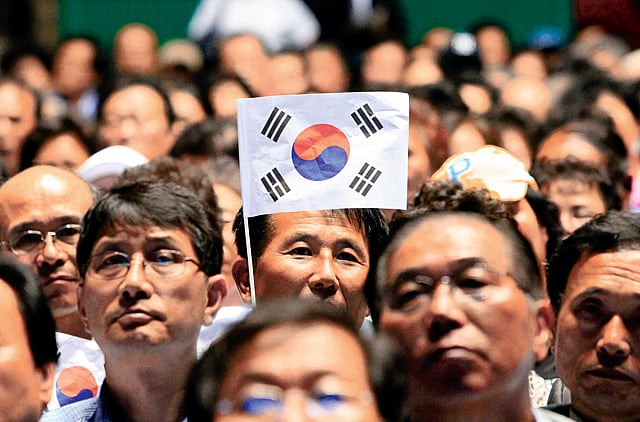All about South Korea
Know more about South Korea with these fun facts

Area: 96,920 sq km
Languages:
Korean (Hangeul), English
Currency: Won (KRW1= Dh0.0031)
Population: 48.754 million (2011 est.)
Harmonious movement: Today being South Korea’s national foundation day, it is interesting to know that the design of the country’s flag — called ‘Taegeukgi’ in Korean — symbolises the principles of the yin and yang in Oriental philosophy.
The circle in the centre of the flag is divided into two equal parts: the upper red section representing the proactive cosmic forces of the yang and the lower blue section representing the responsive cosmic forces of the yin. The two forces together embody the concepts of continual movement, balance and harmony that characterise the sphere of infinity. The circle is surrounded by four trigrams, one in each corner, each trigram symbolising one of the four universal elements: heaven, earth, fire, and water.
To see the ‘real Korea’, head to Andong. Located deep in the Gyeongsangbuk-do province, it’s like going back in time. Here, at the centre of Korea’s Confucian heartland, the old ways coexist with and often even trump the 21st century. Andong is a treasure trove of artefacts from the gentile days of the Joseon era, including magnificent Confucian academies and rustic riverside villages that have changed little over the centuries. There’s no denying that the Confucian way of life still runs strong.
Andong’s unique cultural charm is due to its close association with Korea’s yangban culture. Part scholars, part officials, part landowners, the yangban formed the elite of Joseon-era society, equipped with knowledge of Chinese classics and the intricate system of ritual and etiquette demanded by Joseon’s guiding neo-Confucian ideology.
Today, Andong is a pleasant provincial town and major regional educational centre. Andong’s most famous tourist attraction is Hahoe Village, located on a bend of the Hwacheon Stream, a tributary of the mighty Han River. This idyllic village, surrounded by the meandering Hwacheon and backed by dramatic cliffs, is quite the tourism drawcard with all the trappings. The community itself dates back some 500 years. A bird’s-eye view of the village from Buyongdae, a cliff across the river from the village, is unforgettable. The village is also famous for the Hahoe Byolshin-Gut Tal-Nori, or Hahoe MaskDance Drama.
Back to nature: Jeju-do is one among the official finalists of the worldwide ‘New7Wonders of Nature’ campaign? Within an hour’s flight from Seoul, Busan or Daegu, travellers can reach a land of a completely different character. Recognised as the best-preserved area in the nation, Jeju-do is famous for its natural wonders and is Korea’s only island province. Located south-west of the Korean peninsula, Jeju-do or the Jeju Special Self-Governing Province is one of the world’s major tourist attractions —it lures more than five million visitors per year.
Among Jeju’s natural wonders, three have been recognised as World Heritage Sites by Unesco (2007): Hallasan Mountain, perhaps Jeju’s most prominent geographical feature that rises out of the centre of the island; Seongsan Ilchulbong Peak, recognised for its sedimentological characteristics, is among the best places in the world to study Surtseyan-type volcanic eruptions; and the Geomunoreum Lava Tube System, one of the world’s most extensive series of lava tube caves.
Interested in architecture? Then visit Korea’s south-eastern region, comprising Gyeongsangbukdo (North Gyeongsang Province) and Gyeongsangnam-do (South Gyeongsang Province). The area is rich in tourist attractions, cultural assets and historical places. The Hallyeosudo Waterway and the mountains of Jirisan and Gayasan are among the region’s most outstanding natural resources.
The main architectural sites of Gyeongju, in Gyeongsangbuk- do, are Bulguksa Temple and the nearby Seokguram Grotto. Representing highly refined Buddhist art, both were completed in the eighth century and were included in Unesco’s World Heritage List in 1995.
• South Korea Embassy, P.O. Box 3270, Abu Dhabi.
Tel: +971 2 643 9122; Email: uae@mofat.go.kr;
Website: are.mofat.go.kr
• Consulate General of South Korea,
P.O. Box 126127, Dubai.
Tel: +971 4 344 9200; Email: dubai@mofat.go.kr
Sign up for the Daily Briefing
Get the latest news and updates straight to your inbox
Network Links
GN StoreDownload our app
© Al Nisr Publishing LLC 2025. All rights reserved.